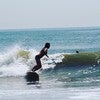Description
About This Video
Transcript
Read Full Transcript
Okay. Today we're going to work on just some basic fundamentals of some posturing body position, landmarks of polarities, and we're going to start really with the rib cage and the the way we like to threes, one of the ways we like to breed, so if we watch the back of the body, we're really looking for expansion of the rib cage and this isn't the way we normally breathe throughout the day, but the plot is breath is really wanting to breathe back into the back of the lungs and the rib cage and try to get some stretch through the back and through the ribs. So if you take that nice full breath in, you can see the widening and the exhale. Just a nice easy narrowing of the ribs reading why and a little narrowing of the [inaudible].
This area widening a bit as well and all the while holidays is focuses so much on vertical extension or axial extension. So being able to take this rich big breaths and stay tall. You're going to hear the queue a lot of stay tall or sit tall. Let me just try one more here.
We can pull the shoulders down and we can do it a little too much and sometimes that will cause the shoulder blades to actually narrow in on the back and kind of restrict some of the movement of the spine right here. So, and she's doing a good job right now of restricting. So we soften out just a little bit and I'm going to have her go up with the shoulders and then instead on the way down to to just be a little mellower with it and just softer and you can note it, you can see how much more width stayed across the upper back. It's actually as if the shoulder blade wraps itself more around this side of the ribs rather than wraps in. And that'll be a little more important when we do weight bearing exercises and certain, uh, other arm positions. It's better for our neck and many other things.
So let's just do one more with the shoulders going up and then gliding down and slightly wrapping forward and just noticing that nice width across the back. So turn sideways now and we're going back to the breathing just so you could see a side view of some other other things and I'm, we'll talk, start talking about the abdominals now. So in the [inaudible] breathing, if we can help it, we'd rather not send the stomach forward or puff forward. If this can stay relatively inward or navel to spine, you're going to hear that cue a lot. And then again trying to reconnect to this lateral or sideways and back breathing and it takes practice. This is, this is an exercise to breathe this way it's not our normal everyday breath pattern or breath breathing style.
So it takes a little bit of practice to get the width and then using the abdominal muscles to bring those ribs a little closer together. And again, noticing the ability to stay very tall on the breath. She's doing a really good job here, keeping the shoulder blades nice and wide on the back. And again, these are all a, this is placement and set up a some fundamental setup for you. All right, so let's go then progress just a little bit and we're going to take her down on the mat. We're going to start talking about the pelvis a little bit more specifically, and I think I'll have this, the setup today, the knees are bent, the feet are forward, slightly of the knees, all 10 toes forward. And we do a lot of discussion about the pelvis and our sits bones and there are the bones at the bottom of the pelvis. So I'm going to reference the bottom of the pelvis down here.
And our heels are in line with those sitz bones. So if we look at the front of our pelvis or the top, we've got a hip bone, a hip moan, and a pubic bone, and the piles work. And the way I cue it is that this is a level triangle or platform. So right now I can see this pelvis is a little, not level, it's slightly angled back into a tilt or sometimes you'll hear it as a tuck. Can you do it a little stronger to Steven? Yeah. Oh, that's a big tuck.
But that we sometimes will see that. So ideally we want a bit more of this angle. So you're really seeing a level platform. I might reference this to just across your hips. All right? Rather than the tilt, which would roll the pelvis back that way.
And sometimes you'll see this in an exercise and a preview for an exercise, but for leveling and set up, we're going to work just on here and this creates a good solid tautness in the abdominals and a good safe position for our back. Now if we go the other way and overshoot it, sending the pelvis forward, see this daylight or this space underneath the back. Again, we were trying to lessen that. Sometimes when we see this, our abdominals aren't working enough and we can stress the back. So we want to do just a good coupling of contraction in the front, reaching the spine to the mat in the back. There we go. And keeping a good level set up here.
So can you breathe like that? Let's just do four breaths. We'll do the inhale through our nose and the exhale on all the wildest, just very level, nothing shifting in the pelvis. I think a good solid contraction or toning and the abdominal muscles.
The movement is here at the hip joint. The knee is right up above the joint of the hip and being able to do this simple movement but with ultimate control and stability in the trunk. So again, it's taking a great deal of work down in the abdomen and the back muscles. Again, the Co contraction around the torso, lower torso. I do it wrong maybe so, so that we'll be watching also in feeling for can the leg lift but maybe not bypass the 90 90 or can the leg lift and not go into the tilt of the pelvis.
And again, all of these things take practice along your journey through Polonius. At the beginning, you may rock a little bit. The stronger you get in your abdomen, in your back, the less you'll rock and you'll have a better understanding of what that feels like to be level, so a progression. Let's do the right leg and hold it here. Now I'm going to have Leah take a breath in through the nose.
As she exhales engaging the abdominals, this leg stays and the left leg will come up with the right leg. She'll stay here to breathe in. Now we're going to lower the first leg while this one stays in place and the next exhale we lower the left so it's an alternating pattern and she'll work right through that. What we're looking for is this control in the trunk contraction and the abdominals keeping an open chest. Again, noticing the triangle of her pelvis, very level, that platform, staying well positioned.
So again, movement right from the joint of the hip knees, right above the hip joint.
So again, if you feel you're back doing this big arch a thank you, you'll want to change this arch. Two ways to change this. Yeah, mainly from your core. You also might lower just the feet a little bit like that to take some of the weight down. Alright. In the stronger than your core gets. You may be able to elevate your shins and things like that, but really be mindful and start really feeling your back and how it's relationship is on the mat. You really want your back touching. But again, not with the losing this triangle of your pelvis. Okay? So then we'll take both legs down again. Great. Okay. And now let's readdress it, the shoulder.
So we'll I'm flat on the Mat. If we do what we did earlier in the warm up and elevate the shoulders, Kinda squishes the neck. And then if we an uninsured the shoulders and move the arms nice and low, you're really creates a stretch right along from the ear to the shoulder. We want that. We want that sense of elongation and that carries itself all the way through the arm, even through the fingertips.
And you'll hear us talk about reach through your fingertips to the end of the mat. That's the reference there, or past your sits bones. So let's go ahead and just raise your arms vertical to the ceiling. And then as you maybe we'll take an exhale, bring your arms all the way down to the mat. Maybe an inch above your mat and again, so again, we're back into the trunk and the triangle. This is absolutely still in stable and you're seeing her shoulders stay lowered down on her head
No in the more you know, sequencing of the regular mat work, you are going to see a head and neck position. Or sometimes we'll call it chest lift or curl head float, which is this and this at the fundamental level. Some of you are going to be fine with and some of you may not like this. I might feel a little bit too much in your neck. You don't have to go there. Again, the stronger this will get, more understanding, you have of your shoulder placement, you'll be able to come up.
So let's just go ahead and lower and we'll do about four more times. It happens on an exhale. Here's where the movement generates exhale. I notice how the head comes up, top of the head, right up to the ceiling and then the wall behind her and all without moving the pelvis. So here she is back in that triangle. Good correction. You may show that again, this, this is where we like to stay. Sometimes a little too much back in that tuck.
It's a little more strengthening to come out level and lower back. Two more times. You'll get very familiar with this position in your [inaudible] mat work. You'll learn to love it and curl back up
You'll hear it as a pump of the arms and sometimes you'll like, you'll be instructed to do a specific breath pattern, maybe an inhale, inhale, exhale, exhale and there little sniffs through the nose and push the air out and push the air out and push the air out. And this might be plenty for you and a fundamental level you may want to challenge it. Maybe in two or three classes and add the head curl. This just intensifies the work quite a bit and you might feel like this, you want a little challenge in a couple of weeks and you might lift one leg up, maybe the second leg up. And this is absolutely fine on a fundamental level to do. Eventually the legs go somewhere else perhaps out there.
This is more the classical hundred you can say there. That would be a better a, you know, more classical form. But we'll do four, three, two, one and rest. Alright, so just showing some levels of progression. I think fundamental, keeping those knees bent or feet down, you're going to have a better chance of really knowing where your abs are and not feel the stress in your neck. Okay, let's find yourself up to sitting and I think you can stay facing that way. We're going to do the butt Belize. All right, so a little more work on articulation and in [inaudible] there is a huge discussion of articulating the spine and it can be just section of the spine, it can be the entire spine. You can start at the top of the spine, it can start at the bottom of the spine and having the strength to segment and move, um, strength and fluidity. So we, we call this but belly or a little rocking of the pelvis. So here she is nice and upright, honors its bones or the triangle again, the two hips and pubic bone. And then if we shift away to the pelvis back that's generated from that tummy contraction that she was just working on down below.
But now we're doing the contraction and moving the pelvis and it's happening on an exhale. So do it. Do it again and involve your whole back, lit, your whole background, even this part. So this is one way to think about it and do it. Nothing wrong with that. That feels probably pretty good through the bid back. But let's try it this way. And that's what Leah was doing before. I'm going to hold my hands here on her and you'll see this part open up toward the back of the mat. And again, we're getting the sense of lengthening and broadening and articulating these lumbar Vertebra.
And then back up into vertical extension and again too contract is coming from the abdominals, opening the back and up to vertical. This can be quite a lot of work in the ABS. Maybe the gluteal muscles are contracting a little bit too. I think that helps to get the bottom engaged. Let's take three more in with your arms reaching forward.
So then another placement, his arms forward just gives a little more stability work and concentration for the shoulder girdle. But this is also a good setup for future exercises where the arms are staying in front of the chest or maybe going up above the chest. So we're going to go into a of rollback and you'll see that we're working the lower back first and working through the middle back and then all the way down to the back of the head on the mat and the arms will just stay right up on reaching to the ceiling. Now in the coming down, this is where we're looking for that core control again and good. No daylight underneath the back. All right, so as you start rolling up, I think lower the arms, head, neck and chest.
Here's the strength to roll up. Reach for the forward wall and then again, find yourself very tall in that sitting vertical position. And then let's go again. Exhale as you contract, shift the weight of the pelvis, an arms to the ceiling. And here we go again. Arms, head, neck and chest and up to a vertical. Eventually your legs may go out straight today. We'll just keep them bent. Yeah, just kind of experience that more from a bent knee position.
So this is doing the articulation of this fine flection of the lower back. Let's take one more time and deep contraction. Holy nose, knees here. Hell vis pelvis, pelvis, pelvis there. That was a little, we might have to do one more repetition now. Yeah, let's go with one more and really, really feel. Watch her pelvis is going to tilt. There it goes. [inaudible] she's squeezing her bottom a little more. I think that's helping get the motion of the pelvis and the lower back and just, it's interesting, her legs have begun to straighten. Um, she does know what she's doing, but eventually let's just try one.
Should we just see this might be where your legs go in a few classes. It might just evolve as as Leah's just did it is a little harder. Well Huh for you. Good. Okay. And then just come back up to sitting tall and that nice vertical axial extension there. All right. And side bending.
We're going to work a fundamental side bending and Lee is going to turn so that sh her back is facing you and we're going to watch the trunk bend from right to left. I'm just going to have you do it a couple times before and sometimes we in a side bend, uh, activity that the pelvis thinks it should come along for the ride and it may do something like that. And so you can maybe see that that's not true spine movement, it's spine and pelvis. So if we go back to our pelvis for just a second and isolate it and park it in place, sit right on your butt bones and then keep those anchored. Now the spine above it has the freedom to move independently. You'll get a different stretch on the opposite side of the back.
You might feel more contraction on the bending side and those are two good things to feel for contraction and stretch and they had is coming along. This is nice. This is part of our spine. The neck and the shoulder blades are staying pretty wide. Stay right there. Actually it might evolve into an arm over the head that might provide against some stretch along the lats on there. On the open side it may help the shoulder blade stay a little wider or challenge them to stay wide. Sometimes they'll, they'll pinch. So can you pinch?
Yeah, there's the pinch which we're trying to get away from. So if we get a little bit more width, here we are and then as you come back up to vertical, the yarn can come down and let's go ahead again and go over to the side and keeping that opposing hip on the mat. Wide shoulder blades on the back and then up to vertical spine and we'll do one more to each side and over keeping that hip anchor down and last time coming to the other side and all the way up to vertical spine. Again, feel the axial extension all the way through the top of the head. The arms can come down and rest. Seated rotation is the next one in the sequencing I'm working with today and the arm position that she's having here is just a folded arms.
You could absolutely put them around the middle of your waist if you'd like to as well. What we're trying to do is first find awareness of how to rotate the trunk and the trunk includes the head. It goes all the way down to the hip. Bones are the base of the hip bones, so I'll use the stick. This is just a reference so you can rotate to your either side. I'm going to have, she's going to her right there it is.
There's a that gets spicket going through our spine that's rotating us all the way around. Now it's easy to let the head go a little too far. So if you let your head go farther than your shoulders, yeah, this is a little bit too far. So her head did not stay in a relationship with the chunk. We want this whole piece to turn in unison in one piece and then she comes back to the center and then if she rotates the other direction, keeping your head right in line.
She hasn't done that. It's very nice. She's kept that base down and then fold the elbows again and come back to center and rotate around. Whole Torso and arms can extend and fold the elbows to come right back to the center.
And we like to teach it in a seated position to learn the understanding of, of how the torso moves in a unit and arrest. Sometimes we'll do it from lying flat in a chest lift. You'll live from the ground a different positions, but the fundamental from seated. Okay. Spinal extension prone. So let's have you put your forehead down here. All right. And we're going to start with the hand stacked in the forehead, right on the hands for a few reasons. You can see, uh, the pelvis a little bit easier with the arms up here.
So for your learning and seeing it now, right now she's not really engaging her abdominal muscles. She's kind of arrest. And what we can see is this, this normal curve. This is our lumbar curve. It's normal. We all have that. Some of us have more than the other a someone else. So if we were to perform a few exercises with that amount of curve in our back, this gets fussy and can get stressed. So a lot of what you'll hear in, um, fundamental classes and ongoing length in your lower back. So one way to length in the lower back, of course, the stomach muscles.
So from the stomach up to the back, the back out longer, I'm going to let go and have her do that again. So you all can see that. So with the work of the abdominals and she's exhaling, that seems to make a nice strong connection. Can you see nice lengthening in their lower back? So that's what we're looking for it. And again, when you're first learning this, it's um, that's challenging to keep that in.
It may dip back in and you'll feel it linkedin back out. So here we are trying to keep this up position. Tommy's lifted and now I'm going to ask Leah to just float her head off of her hands. And it's just like your head is a helium balloon, just floats right up. The muscles in the back are what are being worked right now as well as the stomach. And then bringing the head back down. I'm going to have her take an inhale for nothing or just the preparation and then the exhale to lift and my hand is on the upper back, kind of bright bulb between the shoulder blades and a. Feel your back.
Press up into my hand and then bringing your head back down. And again we're talking shoulder blades. This can involve those shoulder blades down here rather than elevated into the neck. This is going to get your neck a little fussy, so keep checking, pulling them down. Let's do one more time with your hands here. Nice, long, lower back. Take a breath in and exhale as you lower your head down. Stude two more, just two more times with your arms down along your sides. And as the arms are down by the sides, we'll do palms face up and this will involve a few more muscles in the arm and in the side of the back.
And it's good to start knowing what that feels like even at a fundamental level. All right, so again, a nice full breath in and on the exhale, feeling the lift from the back. So this is a little more demanding on the body. The back muscles kind of have to do their own thing. When the arms were here, somewhat easier, the hands were kind of helping to lift the lift the chest. Now we get to lift on her own and then use your exhale also to come back down.
She's doing a really, really nice job of staying along all the way through the top of the head. Watch this. If you lift your head and see up your wall in front of you. Again, neck tension. So we want want her to do much more of that. It's really keeping your eyes looking down. Okay. And your chest reaching forward. And this is a lot.
Maybe one more repetition. Take a breath into the nose and that sense of length through the top, through the bottom, long, lower back, good shoulder position, tummy work, and the exhale to go all the way down and arrest. Okay, one last exercise for today and that's a standing roll down. So we'll find our way up to two feet standing maybe in the middle of the mat. And so just to readdress the vertical extension, we really want to think top of the head without the pushing forward.
We want a nice long lower back. We want a nice set of hip bones here, not too tucked and not too arched. And let's take a breath in through your nose and just a very slow roll downs. We're readdressing the articulation. So we're starting out at the top of the spine trying to bend the Vertebra in the upper back, men through the middle back and keeping the pelvis pleat. Lee stable right up on top of the legs. And I'm going to have her hold right right there. Okay.
So you can see a pretty good curve. Keep working on opening this up, but it, this is a more ideal position than that. That's something different. We may get there eventually, but for right now on our beginning knowledge and fundamentals, we want to know what this feels like to round the back. Keep the hip staff right up over the legs. And then again articulating to vertical spine. We're re walking up all the way and the head will be the very last thing to come up. We'll just do one more roll down, take a big breath in, lateral breath and rolling down.
And all the while in the front stomach muscles really lifted. Take one more breath and exhale walking all the way back up to vertical spine. Thank you. Thank you.
Comments
You need to be a subscriber to post a comment.
Please Log In or Create an Account to start your free trial.






















